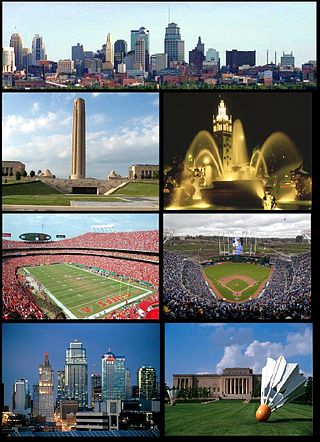
The Kansas City metropolitan area is a bi-state metropolitan area anchored by Kansas City, Missouri. Its 14 counties straddle the border between the U.S. states of Missouri and Kansas. With 8,472 square miles (21,940 km2) and a population of more than 2.2 million people, it is the second-largest metropolitan area centered in Missouri and is the largest metropolitan area in Kansas, though Wichita is the largest metropolitan area centered in Kansas. Alongside Kansas City, Missouri, these are the suburbs with populations above 100,000: Overland Park, Kansas; Kansas City, Kansas; Olathe, Kansas; Independence, Missouri; and Lee's Summit, Missouri.
Associated Wholesale Grocers, Inc. (AWG) is the United States's largest cooperative food wholesaler to independently owned supermarkets and grocery stores. It serves more than 4,000 locations in 36 states and from 8 full-line wholesale divisions. The consolidated run-rate sales for AWG is close to $10 billion. In addition to its cooperative wholesale operations, the company also operates subsidiary companies which provide certain real estate and supermarket development services, digital marketing services, and is a wholesale supply provider of health and beauty care, general merchandise, specialty/international foods and pharmaceutical supplies. It was founded in 1924 as Associated Grocers of Kansas City and was based in Kansas City, Missouri before moving to Kansas City, Kansas. Associated Wholesale Grocers distributes four private-label brands of grocery products, Best Choice, Clearly Organic, Always Save, and Superior Selections along with IGA.

The Historic Third Ward is a historic warehouse district located in downtown Milwaukee, Wisconsin. This Milwaukee neighborhood is listed on the National Register of Historic Places. Today, the Third Ward is home to over 450 businesses and maintains a strong position within the retail and professional service community in Milwaukee as a showcase of a mixed-use district. The neighborhood's renaissance is anchored by many specialty shops, restaurants, art galleries and theatre groups, creative businesses and condos. It is home to the Milwaukee Institute of Art and Design (MIAD), and the Broadway Theatre Center. The Ward is adjacent to the Henry Maier Festival Park, home to Summerfest. The neighborhood is bounded by the Milwaukee River to the west and south, E. Clybourn Street to the north, and Lake Michigan to the east.
Indianapolis has seven designated neighborhoods as Cultural Districts, first established in 1999: Broad Ripple Village; Mass Ave; Fountain Square; Wholesale District; Canal and White River State Park; Indiana Avenue; and Market East. The purpose of these designations was to capitalize on cultural institutions within historically significant neighborhoods unique to the city's heritage for economic development and revitalization.
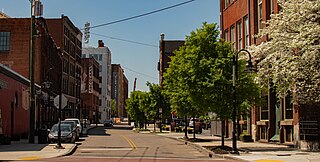
The Old City is a neighborhood in Knoxville, Tennessee, United States, located at the northeast corner of the city's downtown area. Originally part of a raucous and vice-ridden section of town known as "The Bowery," the Old City has since been revitalized through extensive redevelopment efforts carried out during the 1980s through the present. Currently, the Old City is an offbeat urban neighborhood, home to several unique restaurants, bars, clubs, and shops.

Quindaro Townsite was once a settlement, then a ghost town, and later an archaeological site. It is around North 27th Street and the Missouri Pacific Railroad tracks in Kansas City, Kansas. It was placed on the National Register of Historic Places on May 22, 2002.

The New Amsterdam Historic District is a historic district located in Detroit, Michigan. Buildings in this district are on or near three sequential east-west streets on the two blocks between Woodward Avenue and Second Avenue. It was listed on the National Register of Historic Places in 2001.

The Southern Terminal is a former railway complex located at 306 West Depot Avenue in Knoxville, Tennessee, USA. The complex, which includes a passenger terminal and express depot adjacent to a large railyard, was built in 1903 by the Southern Railway. Both the terminal and depot were designed by noted train station architect Frank Pierce Milburn (1868–1926). In 1985, the terminal complex, along with several dozen warehouses and storefronts in the adjacent Old City and vicinity, were listed on the National Register of Historic Places as the Southern Terminal and Warehouse Historic District.

The Portland Railway, Light and Power Company (PRL&P) was a railway company and electric power utility in Portland, Oregon, United States, from 1906 until 1924.

The Crescent Warehouse Historic District is a 10.5-acre (4.2 ha) historic district in Downtown Davenport, Iowa, United States. The district is a collection of multi-story brick structures that formerly housed warehouses and factories. Most of the buildings have been converted into loft apartments. The district was listed on the National Register of Historic Places in 2003.

Kansas City Wholesale Grocery Co. v. Weber Packing Corp., 93 Utah 414 (1937), was a case decided by the Supreme Court of Utah where the court modified a contract to avoid an unconscionable result.

Save Our Heritage Organisation (SOHO) is a non-profit organization devoted to the preservation of the historic architecture and landmarks around the San Diego, California area. Founded in 1969, Save Our Heritage Organisation maintains several historic buildings including the Whaley House and the George W. Marston House. They are directly partnered with the National Trust for Historic Preservation.

The National Building is a historic warehouse building in downtown Seattle, Washington, located on the east side of Western Avenue between Spring and Madison Streets in what was historically Seattle's commission district. It is now home to the Seattle Weekly. It is a six-story plus basement brick building that covers the entire half-block. The dark red brick facade is simply decorated with piers capped with small Ionic capitals and a small cornice, which is a reproduction of the original cornice. Kingsley & Anderson of Seattle were the architects.
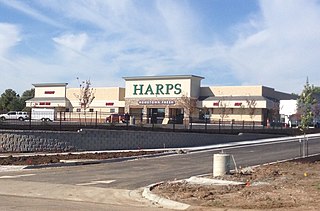
Harps Food Stores, Inc. is an American regional chain of supermarkets based in Springdale, Arkansas. The company operates 151 supermarkets located in the U.S. states of Arkansas, Oklahoma, Missouri, Kansas, Mississippi, and Louisiana. The company sells both groceries and sporting goods in some larger stores, with several locations also incorporating pharmacies and gas stations. In addition to its flagship Harps brand, the company also operates grocery stores under four banners: Food4Less, in southwest Missouri ; CashSaver in Tulsa; 10Box Cost-Plus; Warehouse Market in Tulsa; and The Markets in Louisiana and Mississippi. The company additionally operates a franchise of Ace Hardware in Charleston, Arkansas, Jay, Oklahoma, and Dexter, Missouri.
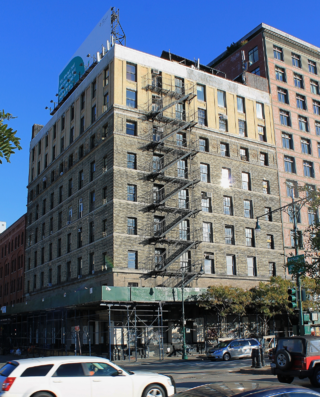
The Great Atlantic and Pacific Tea Company (A&P) Warehouse, located at 67 Vestry Street, is a historic building in the Tribeca section of Lower Manhattan in New York City. Originally a storage building, it was later converted to residential use and has since been historically linked to the New York City arts scene.
Alpha is an unincorporated community in Grundy County, in the U.S. state of Missouri.

Walter C. Root was an American architect practicing in Kansas City, Missouri. He is best known for his major works in Missouri and Kansas, including Dyche Hall on the University of Kansas campus.
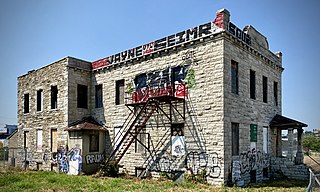
Wheatley-Provident Hospital is a historic site at 1826 Forest Avenue in the 18th and Vine District of Kansas City, Missouri. It was founded in 1902 and became Kansas City's first hospital for Black people.

Hastings Brewery Building and Bottling Works is a historic building located in Hastings, Nebraska. Built in 1907, it is notable for being a pre-Prohibition brewery and its Rundbogenstil style.


















